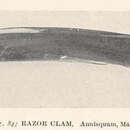Biology
provided by Arkive
Razor shells are deep burrowers and are rarely seen alive; when disturbed they rapidly move down deeper into the sediment (2). They typically position themselves so that two short tubes known as 'siphons' protrude above the surface of the sediment, allowing the mollusc to draw in a respiratory current of water into the body via one siphon, and out via the second. Food is also extracted from this current; this species is a suspension feeder, extracting particles of organic matter from the water (4). The presence of this razor shell in the sediment can be detected by characteristic holes in the sand, similar to keyholes, which are made by the siphons (2).
Maturity is reached after three years and breeding takes place during spring. The larvae live in the plankton for around a month before settling (2). The life span is thought to be around 10 years (2).
Conservation
provided by Arkive
No conservation action has been targeted at this species.
Description
provided by Arkive
This razor shell is a common, burrowing mollusc, which has an elongated fragile and narrow shell shaped like a cut-throat razor, hence the common name (3). The two halves of the shell, known as valves, are somewhat curved; they have a smooth, whitish outer surface with reddish or purplish-brown markings and are covered by an olive-green layer of protein known as the periostracum. The inner surface of the valves is white with a purple hue. The large muscular foot is reddish-brown in colour (2).
Habitat
provided by Arkive
This razor shell burrows in sand or muddy sand from the extreme low water mark to depths of around 60 m (4).
Range
provided by Arkive
Found around the coasts of Britain, and from Norway to the Atlantic coasts of Spain, as well as parts of the Mediterranean (4).
Status
provided by Arkive
Common and widespread (2).
Threats
provided by Arkive
Not currently threatened.

